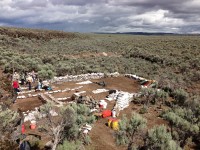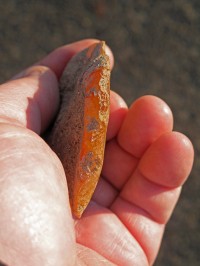 Archaeologists excavating the pre-historic Rimrock Draw Rockshelter outside Riley, eastern Oregon, have discovered a stone scraper underneath a 15,800-year-old layer of ash from an eruption of Mount St. Helens. If the layer can be shown to have been unbroken and that the tool didn’t work its way down through a natural process, the scraper would predate the earliest known sites of human occupation west of the Rockies.
Archaeologists excavating the pre-historic Rimrock Draw Rockshelter outside Riley, eastern Oregon, have discovered a stone scraper underneath a 15,800-year-old layer of ash from an eruption of Mount St. Helens. If the layer can be shown to have been unbroken and that the tool didn’t work its way down through a natural process, the scraper would predate the earliest known sites of human occupation west of the Rockies.
The U.S. Bureau of Land Management (BLM), which administers the land where the rockshelter is found, and the University of Oregon
Archaeological Field School have been excavating the site since 2011. In 2012, they unearthed a small translucent orange chalcedony tool. It’s a thick cortex flake, a stone chipped off a larger piece that has then been further flaked to make a usable tool. This one is had a single edge that was flaked to create a serrated cutting surface. The serrations are smooth and of uniform height, an indication of wear caused by usage. Archaeologists believe it was used for butchering animals, scraping their hides or for carving wood. Blood residue analysis found animal proteins on the scraper consistent with bison, possibly Bison antiquus.
 The scraper was found nine feet into a layer of sand and clay that goes 12 feet down from ground level before terminating in a bedrock layer. Near the bottom of the layer above the scraper, archaeologists found a layer of volcanic ash from the ancient eruption. Other objects found in the sand and clay layer above the agate tool include obsidian projectile points and large fragments of tooth enamel that comparisons with specimens in the paleontological collection of the University of Oregon Museum of Natural & Cultural History indicate came from a Pleistocene camel, a species that went extinct about 13,000 years ago.
The scraper was found nine feet into a layer of sand and clay that goes 12 feet down from ground level before terminating in a bedrock layer. Near the bottom of the layer above the scraper, archaeologists found a layer of volcanic ash from the ancient eruption. Other objects found in the sand and clay layer above the agate tool include obsidian projectile points and large fragments of tooth enamel that comparisons with specimens in the paleontological collection of the University of Oregon Museum of Natural & Cultural History indicate came from a Pleistocene camel, a species that went extinct about 13,000 years ago.
Dr. Patrick O’Grady, with the University of Oregon Archaeological Field School, has been directing the Rimrock Draw Rockshelter excavations since they began.
“When we had the volcanic ash identified, we were stunned because that would make this stone tool one of the oldest artifacts in North America. Given those circumstances and the laws of stratigraphy, this object should be older than the ash,” said O’Grady. “While we need more
evidence before we can make an irrefutable claim, we plan to expand our excavation this summer and hopefully provide further evidence of artifacts found consistently underneath that layer of volcanic ash. That’s the next step.”
 For many years archaeologists believed that the first people to inhabit the Americas were the Clovis people who crossed the land bridge from Siberia around 13,000 years ago when a warm period made some transit space through the previously unsurpassable glaciers covering all of what is today Canada and the northern United States. Recent discoveries, like the 14,300-year-old fossilized feces found in Oregon’s Paisley Caves in 2008, suggest humans may have come over earlier than that, perhaps following a coastal route down the Pacific Northwest that was less ice-choked.
For many years archaeologists believed that the first people to inhabit the Americas were the Clovis people who crossed the land bridge from Siberia around 13,000 years ago when a warm period made some transit space through the previously unsurpassable glaciers covering all of what is today Canada and the northern United States. Recent discoveries, like the 14,300-year-old fossilized feces found in Oregon’s Paisley Caves in 2008, suggest humans may have come over earlier than that, perhaps following a coastal route down the Pacific Northwest that was less ice-choked.
The team will continue the excavation this summer and hope to discover if the ash layer covers the whole area without any breaks. If they can prove that the layer is undisturbed, that will confirm that there were people making tools and eating Pleistocene fauna at the Rimrock Draw Rockshelter 1,500 years before the earliest pre-Clovis site known.